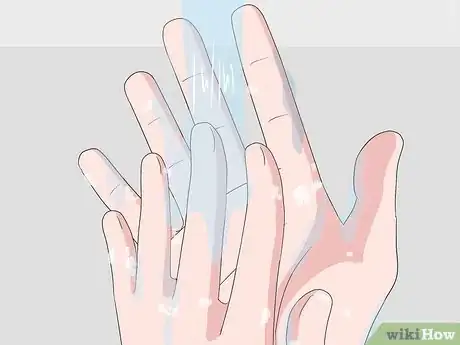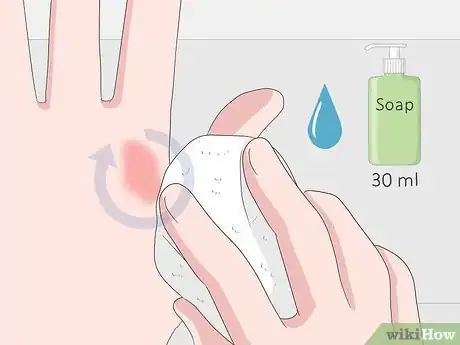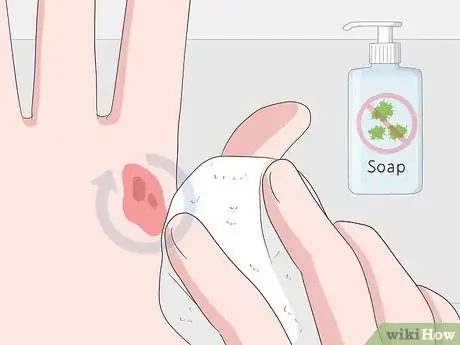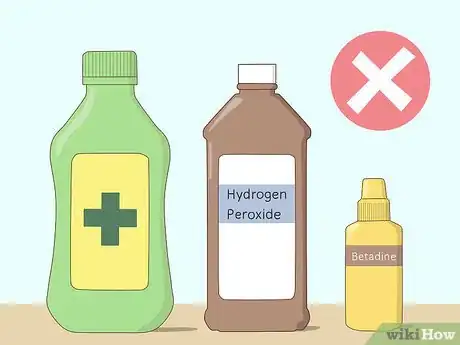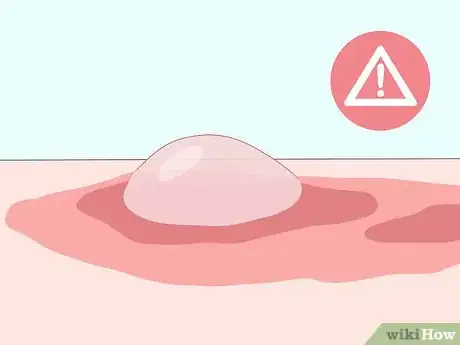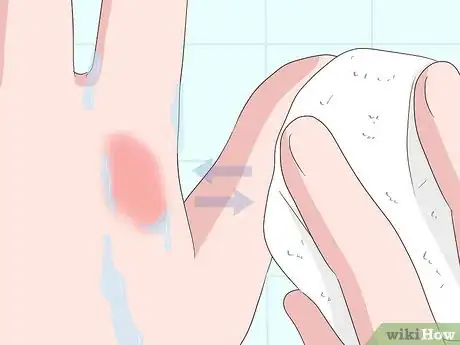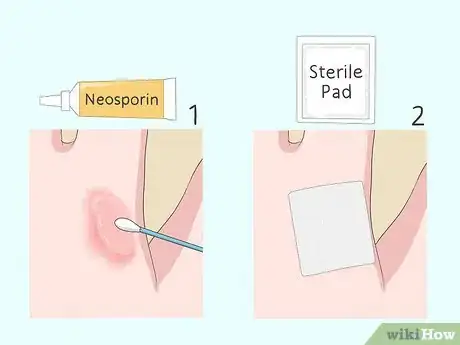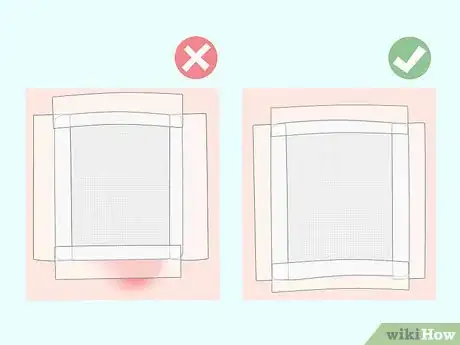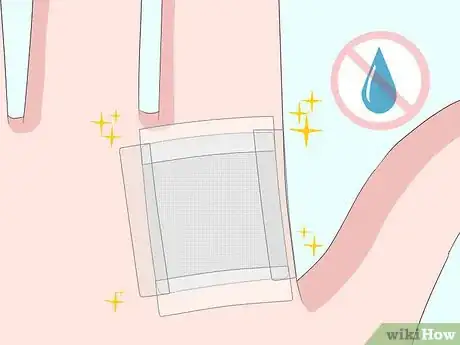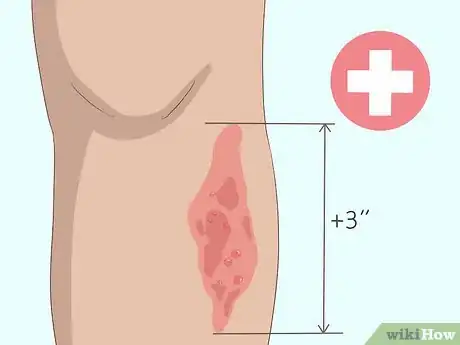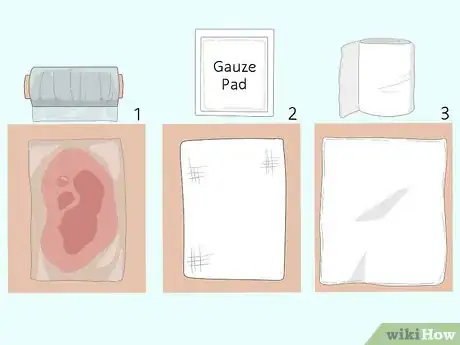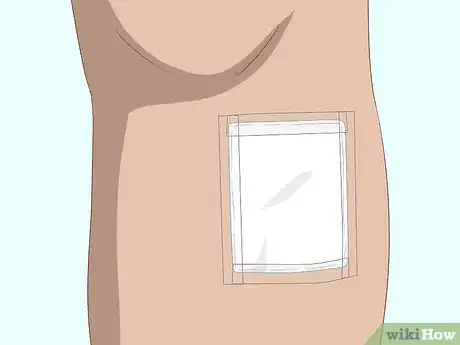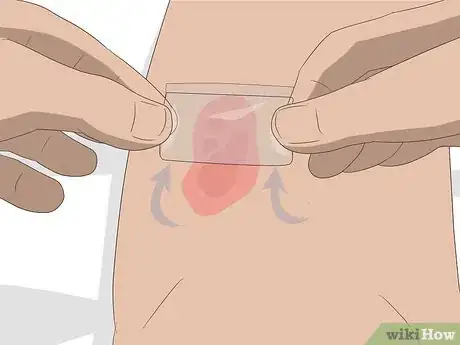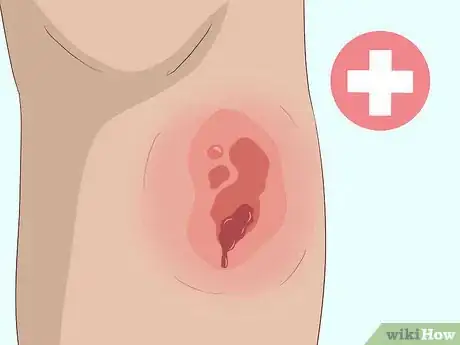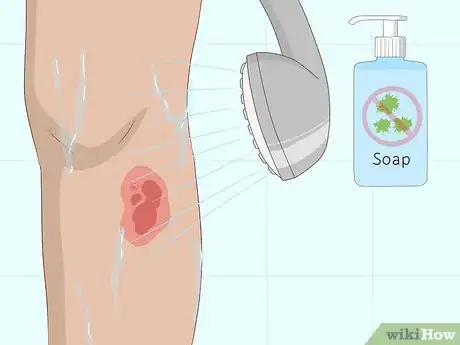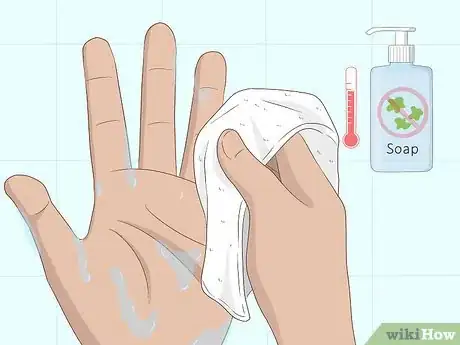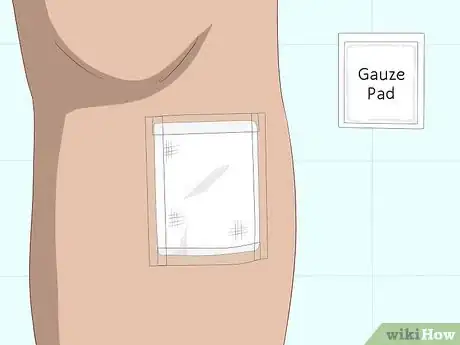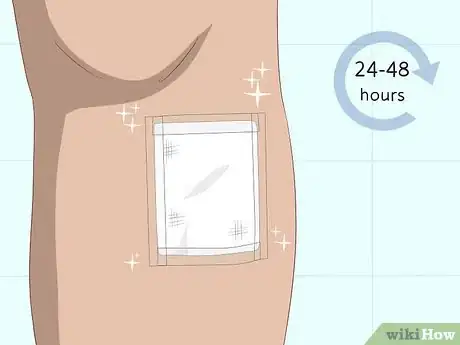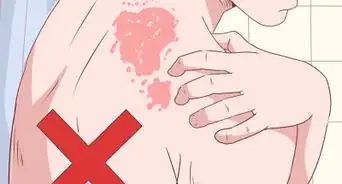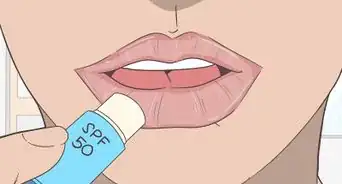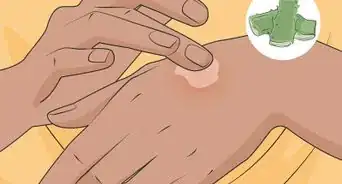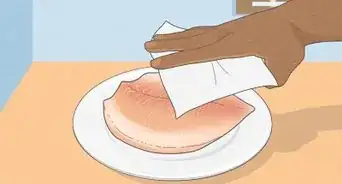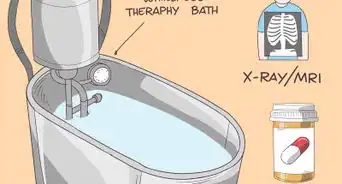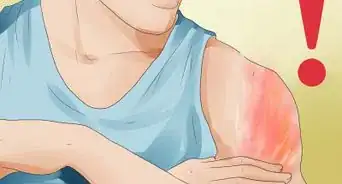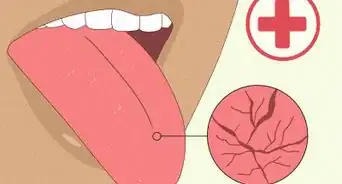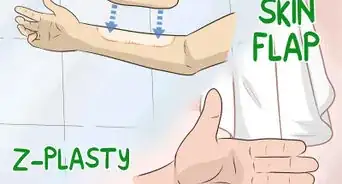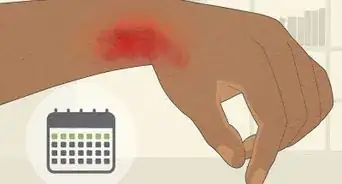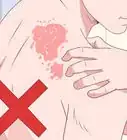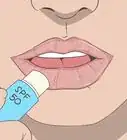This article was medically reviewed by Luba Lee, FNP-BC, MS. Luba Lee, FNP-BC is a Board-Certified Family Nurse Practitioner (FNP) and educator in Tennessee with over a decade of clinical experience. Luba has certifications in Pediatric Advanced Life Support (PALS), Emergency Medicine, Advanced Cardiac Life Support (ACLS), Team Building, and Critical Care Nursing. She received her Master of Science in Nursing (MSN) from the University of Tennessee in 2006.
There are 12 references cited in this article, which can be found at the bottom of the page.
This article has been viewed 21,811 times.
Whether you’ve accidentally touched a hot stovetop or curling iron, burns hurt—a lot! See a doctor immediately if the burn is severe, longer than 3 inches (7.6 cm), or covers a joint.[1] If not, you can treat probably treat a mild or moderate burn at home. Once you’ve cooled the skin, covering (or dressing) the burn properly will help speed up the healing process.[2]
Steps
Cleaning the Burn
-
1Cool the burn immediately with cool water or saline-soaked gauze. Taking quick action to cool the burn down can prevent it from getting worse. Run cool water over the burn from your tap for about 20 minutes.[3] Alternatively, soak a clean piece of gauze in saline solution and put it on the burn.
- Don’t put ice on the burn or submerge the burned skin in water or any other fluid.
-
2Wash your hands really well before cleaning the burned skin. You’ll want to prevent the burn from possibly becoming infected by keeping it free of bacteria. So, make sure to wash your hands completely to avoid transferring bacteria from your hands to the burn.
- If your hands are burned, though, you should go to your doctor’s office or the hospital immediately.[4]
Advertisement -
3Rub mild burns with water to clean them, with or without mild soap. Mild burns, also known as first degree burns, affect the top layer of skin (the epidermis), and can almost always be treated at home.[5] While the risk of a mild burn becoming infected is fairly low, you should still clean it by wetting a clean washcloth, applying about 1 fluid ounce (30 mL) of soap to it, and lightly swabbing the burn, using circular motions.[6]
- You can also clean the burn with a little saline solution.
-
4Treat moderate burns with antibacterial soap. More severe burns, known as second-degree burns, may bleed or ooze during the healing process and are usually quite painful.[7] You need to disinfect the wound. Put a bit of antibacterial soap on a clean washcloth and massage the wound with it gently and thoroughly in a circular motion.
-
5Avoid using antiseptics such as alcohol or hydrogen peroxide. These cleansers are harsh and can irritate your burn further. They may ultimately delay the healing process.[8] Even milder antiseptics, such as Hibiclens or Betadine, may do more harm than good.
- Stick to minor cleansers like water and mild soap or saline solution.
-
6Take care not to break any blisters. Blisters help cushion burned or damaged skin and protect it from infection while it is healing. Wash the area as gently as possible to avoid bursting any of the blisters or irritating the burned skin further.[9]
- You can gently wash the blisters with cool water and mild soap, but don’t rub or scrub the area.
-
7Dry the wound gently. The burned skin is probably sensitive to the touch, so make sure to softly pat it with a clean cloth. Rubbing too hard can be very painful and can tear skin. You want to dab the area just enough to remove any extra moisture.[10]
Dressing Mild Burns
-
1Apply antibacterial ointment and cover the burn with a sterile pad. Once you’ve cleaned your burn, gently cover it with a thin layer of an antibiotic ointment, such as bacitracin or Neosporin.[11] Then, apply a sterile pad large enough to cover the wound. Compressing the wound can slow the healing process, so just cover the burn with the pad. Do not wrap the wound with gauze, or use Bandaids!
- Bandaids can interfere with the healing process by constricting circulation and adhering to the burn itself, making them hard to remove without tearing skin.
-
2Cut enough strips of medical tape to fasten the pad to the skin. Place them along the edges of the pad to hold it in place. Then tamp them down delicately, but firmly. Make sure the pad does not compress the wound, and that the tape is not placed on any part of the wound.
-
3Keep your dressing clean and dry. If your dressing gets soaked or soiled, it could delay healing or lead to an infection. Keep an eye on your dressing and keep it out of water and away from contaminants as much as possible. If the pad becomes wet or dirty, remove it and replace it with a fresh dressing.
- If necessary, clean your burn again before re-applying the dressing.
Covering Moderate Burns
-
1Go to the doctor if the burn is longer than 3 inches (7.6 cm) or covers a joint.[12] These kinds of burns are more serious and should be treated by a professional immediately to make sure they heal properly.
-
2Use cling film, gauze, and cotton wool to dress less severe moderate burns. These additional types of dressing can soak up any fluid from a healing burn. They can also help protect the injury from infection or excess sunlight, either of which would slow the body's natural healing process. To dress the burn:
- Lay cling film on the wound. Cling film is a commercially available type of dressing that is tight, transparent, pliable, and non-adhesive. If you don't have cling film, a sterile cotton pad can be used as the first layer of dressing.[13] . Do not compress the burn with the cling film.
- Place a gauze pad over the cling film or cotton pad. Again, avoid wrapping the wound with the gauze. Use a large enough pad to cover the injury, no larger.
- Cover the gauze pad with cotton wool dressing. The wool will absorb any fluid that is discharged from the wound as it heals.
-
3Tape the dressing to the skin. Pull a few strips of medical tape from a dispenser, then lightly place them along the edge of the dressing. Press the strips down gently but firmly until the dressing is secure.
- Make sure the dressing is not on tightly enough that it compresses the wound.
Changing the Dressing
-
1Remove the dressing after 48 hours. At this time, you or a doctor can begin to see how well the burn is beginning to heal.[14] Wash your hands with antibacterial soap, then dry them before touching the dressing. Then you’ll want to gently peel back the adhesive tape with your fingers, lifting it away from your skin. Pull up and discard the cotton wool, gauze pad, and cling film or cotton sheet.
-
2Schedule a doctor’s appointment immediately if the wound is swelling, itching, or bleeding. These are signs that the burn may not be healing properly. You or the burn victim may need medical treatment or a special dressing.[15]
-
3Use an antibacterial wash to clean any remaining fluid or dead skin. Even if you plan to see a doctor, you’ll still need to finish applying a new dressing before getting to their office. Before you do so, make sure your wound, and the area around it, is clean. You’ll also need to finish applying a new dressing to the wound before you get there.
-
4Wash your hands before redressing the wound. You want to avoid getting any of the fluid or bacteria you just wiped away back into the burn area. Wet your hands with warm water and scrub them thoroughly with a warm cloth covered with antibacterial soap.
-
5Apply a new dressing to the area. Depending on how well the burn is healing, a simple gauze pad may suffice. Cover the burn with the pad and use medical tape to hold it in place. With moderate burns, the second dressing should be applied the same way as the first:
- Cover the burn with another piece of cling film or cotton wool.
- Place a fresh gauze pad on top, followed by 2 to 3 layers of absorbent cotton wool.
- Secure the new dressing in place with adhesive tape.
- Throw the old dressing away.
-
6Re-examine the dressing periodically. Every 24 to 48 hours, you should examine the dressing to see if it needs changing. You may need to change the dressing if the wound is bleeding, oozing other fluids, or giving off a strong smell.
- Consider following up with a doctor to examine moderate burn injuries at least once, even if they don’t seem to be severe. Unless you have had medical training, it might be difficult for you to determine if the skin is healing properly. A doctor can also help you determine whether you are applying your dressing the right way.
Warnings
- Don’t apply ice to the burn when cleaning it, as this can cause tissue damage.[17]⧼thumbs_response⧽
- Avoid topical creams when dressing moderate to severe burns as they can interfere with a medical assessment of how severe the burn is.[18]⧼thumbs_response⧽
- Don't put butter on a burn. Butter, or other substances containing grease, can trap heat, and make it more difficult for burns to heal.[19]⧼thumbs_response⧽
- Avoid applying wet dressings to burn injuries, as they can result in a loss of body heat.[20]⧼thumbs_response⧽
References
- ↑ https://advancedtissue.com/2015/06/6-mistakes-to-avoid-with-burn-wounds/
- ↑ https://www.ncbi.nlm.nih.gov/pmc/articles/PMC428524/
- ↑ https://www.healthline.com/health/home-remedies-for-burns#best-remedies
- ↑ https://www.healthlinkbc.ca/health-topics/sig256965
- ↑ https://msktc.org/burn/factsheets/Wound-Care
- ↑ https://www.cincinnatichildrens.org/health/b/burndress
- ↑ https://msktc.org/burn/factsheets/Wound-Care
- ↑ https://www.medicaldaily.com/dangers-hydrogen-peroxide-242258
- ↑ https://www.summitmedicalgroup.com/library/adult_health/aha_first_aid_for_second-degree_burns/
- ↑ https://www.healthlinkbc.ca/health-topics/sig256965
- ↑ https://burnstrauma.biomedcentral.com/articles/10.1186/s41038-017-0096-6
- ↑ https://advancedtissue.com/2015/06/6-mistakes-to-avoid-with-burn-wounds/
- ↑ http://www.vicburns.org.au/first-aid/thermal/cover-the-burn/
- ↑ https://www.racgp.org.au/afp/2017/march/burns-dressings/
- ↑ https://www.ncbi.nlm.nih.gov/pmc/articles/PMC428524/
- ↑ https://www.uptodate.com/contents/skin-burns-beyond-the-basics
- ↑ https://www.healthlinkbc.ca/health-topics/sig256965
- ↑ https://www.ncbi.nlm.nih.gov/pmc/articles/PMC428524/
- ↑ https://advancedtissue.com/2015/06/6-mistakes-to-avoid-with-burn-wounds/
- ↑ https://www.ncbi.nlm.nih.gov/pmc/articles/PMC428524/

